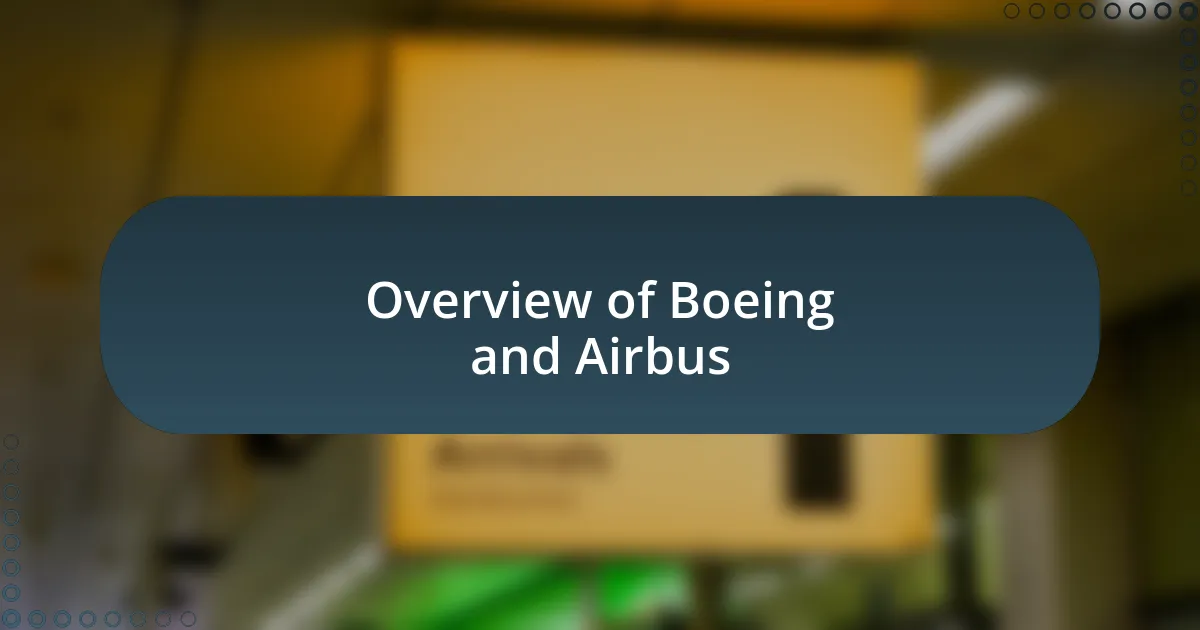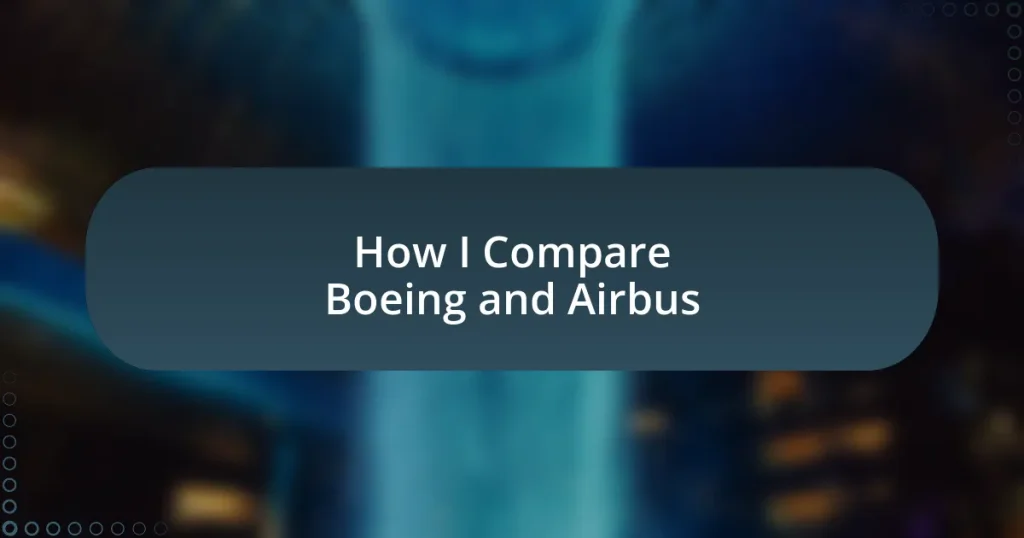Key takeaways:
- Boeing and Airbus have distinct design philosophies, with Boeing favoring tradition and Airbus embracing bold innovation.
- Boeing’s 787 Dreamliner and Airbus’s A320 are key examples of technological advancements that enhance fuel efficiency and safety.
- Airbus has a leading market share in narrow-body aircraft, while Boeing dominates long-haul markets, leading to a dynamic competition that fosters innovation.
- The rivalry between the two companies drives improvements in technology and passenger experience, promising a more efficient and sustainable future for aviation.

Overview of Boeing and Airbus
When comparing Boeing and Airbus, you quickly realize that both companies have carved their own unique paths in the aviation industry. Boeing, with its rich history dating back to 1916, has long been a symbol of American engineering innovation. Meanwhile, Airbus, established in 1970 as a European venture, emerged to challenge that legacy and has done so with remarkable success.
I still remember my first flight on an Airbus A380; the sheer size and comfort left me awestruck. It made me wonder why Airbus chose such bold designs while Boeing often sticks with familiar concepts. This reflects their differing philosophies: Boeing tends to prioritize a more traditional approach, while Airbus embraces bold, modern designs that challenge conventional wisdom.
The dynamic between the two is fascinating, particularly in terms of market competition. Have you ever thought about how these companies drive each other to innovate? It’s exhilarating to see how they push the boundaries, ultimately benefiting passengers with more choices, improved safety, and enhanced experiences. Their competition creates a vibrant landscape in aviation, shaping the future of flying for all of us.

Innovation and Technology in Aircraft
When it comes to innovation and technology in aircraft, Boeing and Airbus both bring unique philosophies to the table. I’ve always found it intriguing how Boeing emphasizes technical refinement while also pushing the boundaries of materials and aerodynamics. For instance, the introduction of the 787 Dreamliner marked a significant leap with its use of composite materials, which not only reduced weight but also improved fuel efficiency. On the other hand, Airbus’s A320 family revolutionized single-aisle aircraft with its fly-by-wire technology, which enhances safety and allows for smoother flights.
- Boeing’s 787 Dreamliner features composite materials for lighter weight and better fuel efficiency.
- Airbus utilized fly-by-wire systems in their A320 family, improving safety and flight control.
- Both companies continually invest in fuel-saving technologies, such as advanced engines and wing designs.
- Boeing is exploring autonomous flight technology to enhance safety and operational efficiency.
- Airbus is focusing on environmentally friendly practices, aiming to achieve zero emissions by 2035.
It’s exciting to think about the future of aviation as these giants continue to innovate. I still vividly recall flying on a Boeing 777 equipped with new engine technology that made the flight quieter and more pleasant. These advancements not only improve travel comfort but also reduce the environmental impact, something I believe is increasingly important to many travelers today.

Market Share and Industry Impact
When analyzing market share, Airbus often holds a slight edge over Boeing, especially in the narrow-body segment. It’s fascinating to note how, during my travels, I’ve seen many airlines opt for Airbus A320s over Boeing’s alternatives due to their perceived operational efficiency and lower maintenance costs. This has undeniably given Airbus a stronghold in key markets, altering the competitive landscape of commercial aviation.
However, Boeing’s dominant presence in long-haul markets cannot be overlooked. I recall discussing with a pilot friend how the Boeing 777 and 787 have become preferred choices for international routes, largely due to their reliability and passenger comfort. This balance between market segments highlights how both companies impact airline fleet decisions and traveler experiences.
Moreover, the rivalry between Boeing and Airbus has prompted continuous advancements in technology and safety standards. I find this competition invigorating; it encourages innovation that ultimately benefits us, the passengers. With both companies aiming to capture larger pieces of the market, we’re witnessing a dynamic shift in how airlines approach fleet management and operational strategies. How does this impact our future travels? Well, I believe it promises a more efficient and enjoyable flying experience, one where we can expect more sustainable practices in our skies.











